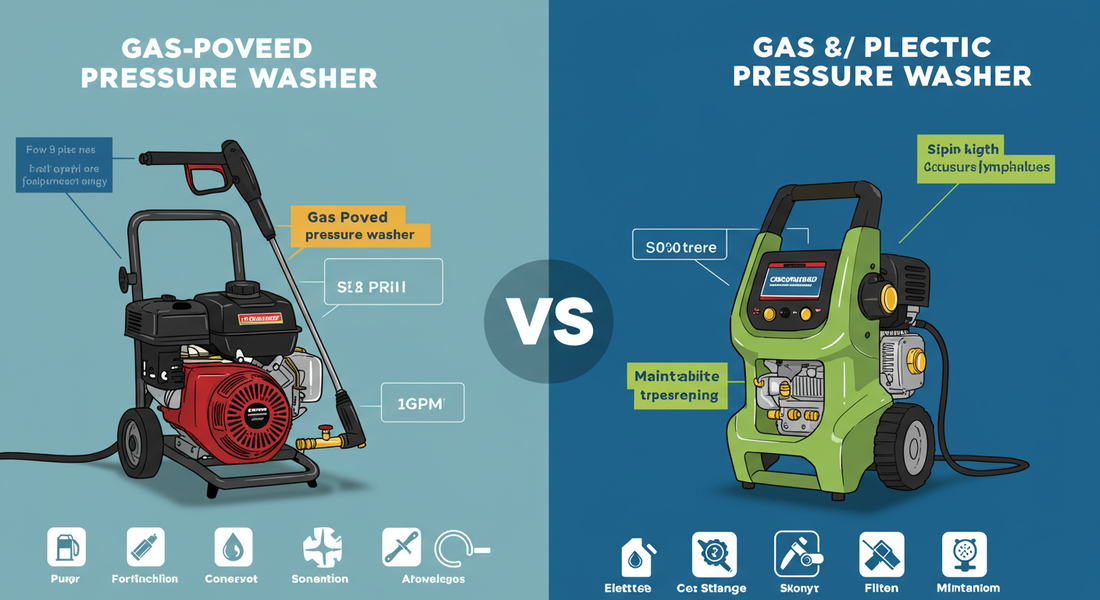
Pressure Washer Buyer's Guide: Gas vs. Electric and PSI/GPM Explained
Share

There are few home maintenance tools as instantly gratifying as a pressure washer. With a simple pass, it can erase years of built-up dirt, grime, and mildew, transforming a dingy-looking driveway, deck, or siding back to its former glory.
This ultimate cleaning power makes it a must-have for any homeowner. But knowing how to choose pressure washer that's right for you can be confusing. This guide will demystify the specs, explain the gas vs electric pressure washer debate, and show you how to use your new tool safely and effectively.
Gas vs. Electric: Which is Right for You?
The first and biggest decision you'll make is the power source.
-
Electric Pressure Washers:
-
Pros: They are lightweight, quiet, relatively inexpensive, and require virtually no maintenance. They are perfect for small to medium-sized jobs around the house.
-
Cons: They are less powerful than gas models, and your range is limited by the length of your power cord and hose.
-
Best For: Washing cars, cleaning patio furniture, small decks, and grills.
-
-
Gas Pressure Washers:
-
Pros: They offer maximum power and complete portability. They are the go-to choice for tackling large, tough jobs quickly and efficiently.
-
Cons: They are heavy, loud, more expensive, and require regular engine maintenance (oil changes, spark plugs, etc.).
-
Best For: Large driveways, stripping paint, cleaning second-story siding, and heavy-duty concrete cleaning.
-
Decoding the Numbers: PSI and GPM
You'll see two main numbers used to measure a pressure washer's power. Understanding what is PSI and GPM is key to choosing the right model.
-
PSI (Pounds per Square Inch): This is the measure of the pressure, or cleaning force, of the water. A higher PSI means more power to blast away tough, stuck-on grime.
-
GPM (Gallons Per Minute): This is the measure of the water flow. A higher GPM means you are rinsing away dirt and debris faster, which can significantly speed up your cleaning time.
-
Cleaning Power Units (CPU): To get the true cleaning power of a machine, multiply PSI x GPM. A higher CPU means a faster, more effective clean.
Here’s a simple chart matching power ratings to common jobs:
|
Job |
Recommended PSI |
Recommended GPM |
|---|---|---|
|
Cars, Outdoor Furniture |
1,300 - 1,900 |
1.5 GPM |
|
Decks, Patios, Siding |
2,000 - 3,000 |
2.5 GPM |
|
Concrete, Paint Stripping |
3,000+ |
3.0 - 4.0 GPM |
Nozzles and Attachments Make the Difference
The nozzle you use controls the angle and intensity of the water spray. Most pressure washers use a standard set of color-coded quick-connect tips.
-
0° (Red): A pinpoint jet. Incredibly powerful but can easily damage surfaces. Use with extreme caution.
-
15° (Yellow): A narrow fan. Good for heavy-duty cleaning on hard surfaces like concrete.
-
25° (Green): A wider fan. This is the most versatile, all-purpose nozzle for most tasks.
-
40° (White): A very wide fan. Best for delicate surfaces like windows and vehicles.
-
Soap (Black): A low-pressure nozzle that is used to apply detergent.
-
Must-Have Attachments: For cleaning large, flat areas like driveways, a surface cleaner attachment is a game-changer. It prevents streaking and speeds up the job immensely. An extension wand is essential for safely cleaning second stories.
Basic Safety and Technique
A pressure washer is a powerful tool, not a toy.
-
Protective Gear: Always wear safety glasses or goggles to protect your eyes from flying debris. Closed-toe shoes are also a must.
-
Avoid Damage: Never use a narrow-degree nozzle (red or yellow) on soft wood, vinyl siding, or your car's paint. Hold the nozzle at least 12-18 inches away from the surface and start with a wider-angle nozzle first, only moving to a narrower one if needed. Keep the wand moving to avoid concentrating the spray in one spot for too long.
Conclusion: Your Go-To Tool for a Deep Clean
Choosing the best pressure washer comes down to an honest assessment of your needs. For the average homeowner, a medium-duty electric pressure washer is often the perfect balance of power, convenience, and affordability. By understanding the basics of PSI, GPM, and proper nozzle use, you can unlock the ultimate cleaning power for your home, safely and effectively.
